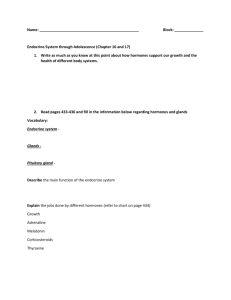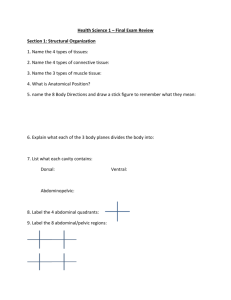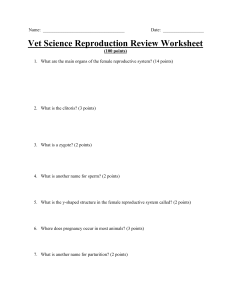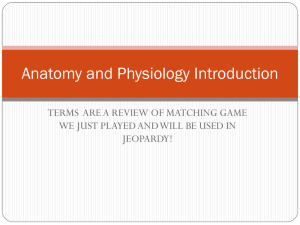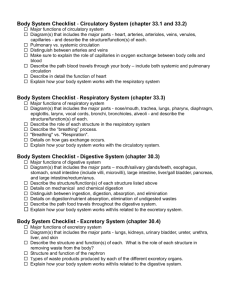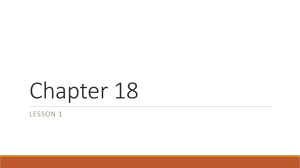Lesson 1: Reproductive Systems - Education and Advanced Learning
advertisement
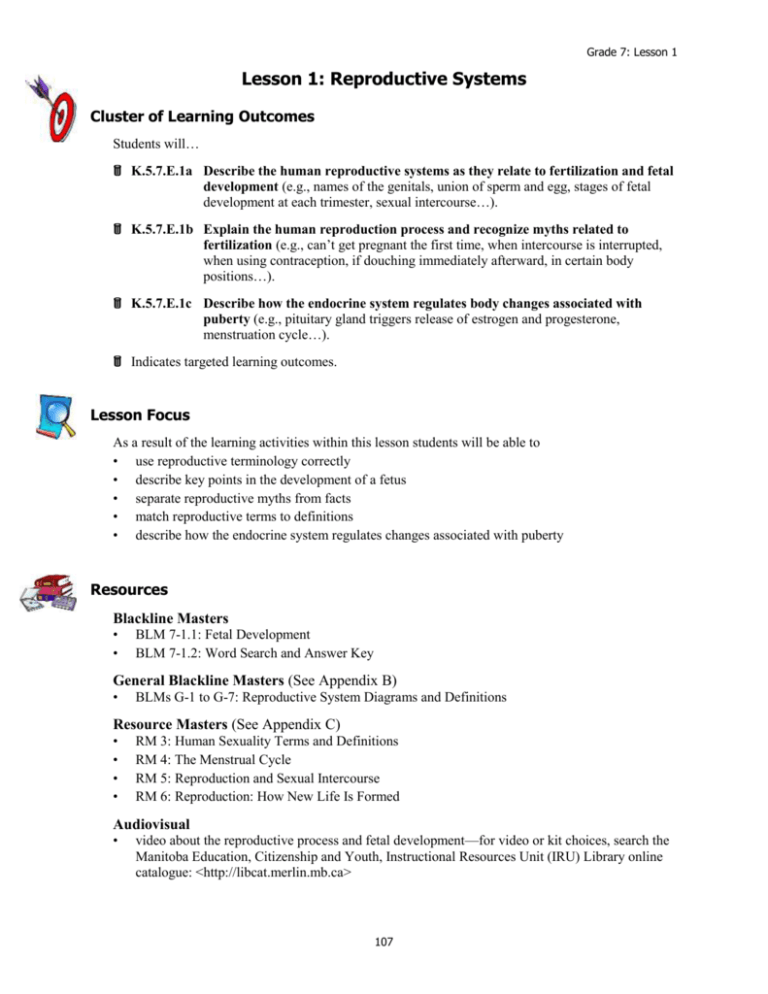
Grade 7: Lesson 1 Lesson 1: Reproductive Systems Cluster of Learning Outcomes Students will… K.5.7.E.1a Describe the human reproductive systems as they relate to fertilization and fetal development (e.g., names of the genitals, union of sperm and egg, stages of fetal development at each trimester, sexual intercourse…). K.5.7.E.1b Explain the human reproduction process and recognize myths related to fertilization (e.g., can’t get pregnant the first time, when intercourse is interrupted, when using contraception, if douching immediately afterward, in certain body positions…). K.5.7.E.1c Describe how the endocrine system regulates body changes associated with puberty (e.g., pituitary gland triggers release of estrogen and progesterone, menstruation cycle…). Indicates targeted learning outcomes. Lesson Focus As a result of the learning activities within this lesson students will be able to • use reproductive terminology correctly • describe key points in the development of a fetus • separate reproductive myths from facts • match reproductive terms to definitions • describe how the endocrine system regulates changes associated with puberty Resources Blackline Masters • • BLM 7-1.1: Fetal Development BLM 7-1.2: Word Search and Answer Key General Blackline Masters (See Appendix B) • BLMs G-1 to G-7: Reproductive System Diagrams and Definitions Resource Masters (See Appendix C) • • • • RM 3: Human Sexuality Terms and Definitions RM 4: The Menstrual Cycle RM 5: Reproduction and Sexual Intercourse RM 6: Reproduction: How New Life Is Formed Audiovisual • video about the reproductive process and fetal development—for video or kit choices, search the Manitoba Education, Citizenship and Youth, Instructional Resources Unit (IRU) Library online catalogue: <http://libcat.merlin.mb.ca> 107 Grade 7: Lesson 1 Print/Publications • • Aboriginal Nurses Association of Canada and Planned Parenthood Federation of Canada. Finding Our Way: A Sexual and Reproductive Health Sourcebook for Aboriginal Communities. Ottawa, ON: Aboriginal Nurses Association of Canada and Planned Parenthood Federation of Canada, 2002. For topic-related resources, consult Manitoba Education, Training and Youth. Human Sexuality and Sexual Orientation: A Bibliography, September 2002. Winnipeg, MB: Manitoba Education, Training and Youth, 2002. Available online at: <http://www.edu.gov.mb.ca/ks4/iru/publications/bibliographies/index.html>. Organizations/Websites • • For lesson plans and additional information, see the following website, maintained by The Society of Obstetricians and Gynaecologists of Canada: <http://www.sexualityandu.ca>. For pictures and descriptions of fetal development in pregnancy, see the website of Sutter Health: <http://www.babies.sutterhealth.org/babygrowth/fetaldev/> Professionals • • public health nurses (for kits containing models of fetal development) Elder/religious leader Notes to Teacher Be sensitive to different cultural perspectives on reproductive health. Review RMs 3 to 6 before this lesson. The Endocrine System Endocrine glands include the thyroid, parathyroid, adrenal, part of the pancreas, pituitary, and sex glands. These glands work together to maintain metabolism and harmony among body organs. A gland can be defined as a tissue or an organ that produces a chemical substance. Endocrine glands secrete hormones into the bloodstream and influence many body processes. The effect of hormone secretion can be both general and specific. For example, the thyroid gland produces thyroxin, which affects general body metabolism. The pituitary gland produces oxytocin, which stimulates contraction of the uterine muscles. The pituitary gland is located below the brain near the centre of the head. It is considered the master endocrine gland because its secretions influence the activity of many other glands. These secretions include a growth-stimulating hormone, sexual-development hormones, a kidney-regulating hormone, as well as hormones influencing both the thyroid and adrenal glands. The gonads or sex glands are the ovaries in females and the testicles (testes) in males. The secretions of these glands help to differentiate male and female characteristics. From birth to puberty, these secretions are regulated by pituitary hormones. Hormones secreted by these glands during puberty cause the development of physical sexual characteristics. The ovaries in the female produce estrogen and progesterone, which regulate the menstrual cycle and production of the ova or eggs. The testicles (testes) secrete testosterone, which regulates the development of male sexual characteristics and sperm cell production. 108 Grade 7: Lesson 1 Curricular Connections ELA: GLO 1—Explore thoughts, ideas, feelings, and experiences GLO 3—Manage ideas and information GLO 4—Enhance the clarity and artistry of communication GLO 5—Celebrate and build community Family Involvement • • Recommend a book about puberty for parents. Examples: Hickling, Meg. More Speaking of Sex: What Your Children Need to Know and When They Need to Know It. Kelowna, BC: Northstone, 1999. ---. Speaking of Sex: Are You Ready to Answer the Questions Your Kids Will Ask? Kelowna, BC: Northstone, 1996. Students could prepare a brief book report and have it signed by parents. Suggestions for Instruction 1. Review diagrams of the male and female reproductive systems, using BLMs from Appendix B as transparencies. Refer to BLMs G-1 to G-7: Reproductive System Diagrams and Definitions. 2. Have students view a video that explains the fertilization process and fetal development. To encourage active listening, ask students to record questions as they watch the video. Have students cut up pieces of paper to signify the size of the fetus at each stage of fetal development. Discuss the similarities and differences between the reproductive process of humans and animals. Hand out copies of BLM 7-1.1: Fetal Development. 3. The Progression of Life: Divide the class into four groups of equal size, and assign each group a period in the human reproductive process (e.g., fertilization, first trimester, second trimester, third trimester). Have each group prepare a presentation to show what happens during a particular stage of development, using diagrams, models, or drawings to support the research findings. Variation: Each group could prepare and contribute PowerPoint slides for a whole-class presentation. 4. What Have You Heard? Discuss the various myths or misconceptions related to fertilization. Ask all students to write down on a slip of paper something they have heard related to fertilization, and indicate whether they believe it to be true or false. Put all the slips into a box. Randomly pull out the slips, one at a time, read each statement, and ask students to hold up a True or False card. Discuss the various answers. Put the facts on one chart and the myths on another. 109 Grade 7: Lesson 1 Examples of Myths: Pregnancy can’t happen • the first time a couple has sex • if a couple has sex standing up • during menstruation • if she washes or urinates after sex • if he withdraws before ejaculation • if she hasn’t had her first period 5. Arrange students in pairs and have them match words to definitions on a BLM provided. Review student responses as a class. Refer to BLM 7-1.2: Word Search and Answer Key. 6. Endocrine System Discussion: Have students find their pituitary gland and point to it (most students will not know where it is). Ask students to touch the base of their scalp at the back of the neck. Explain that this is the location of the pituitary gland, which triggers the release of hormones (testosterone in boys and estrogen in girls). These hormones, in turn, trigger growth and development (puberty). Remind students that all the body changes associated with puberty occur at individual rates and to varying degrees. Suggestions for Assessment Journal/Learning Log Teacher Assessment: Inventory To check for understanding, have students respond (in their Grade 7 Journal/Learning Log) to questions related to the targeted learning outcomes. Questioning/Interview Teacher Assessment: Inventory Assess whether students are able to • recognize myths related to fertilization • explain the process of human reproduction • record one characteristic of the embryo/fetus in each trimester Journal/Learning Log: Endocrine System Research Teacher Assessment: Checklist Ask students to describe (in their Grade 7 Journal/Learning Log) the role of the endocrine system. Suggested Criterion: Observe whether students are able to describe how the endocrine system regulates the body changes associated with puberty. Yes No Note: The mini-presentation can be assessed by using teacher- or student-generated rubrics that incorporate English language arts learning outcomes. 110
